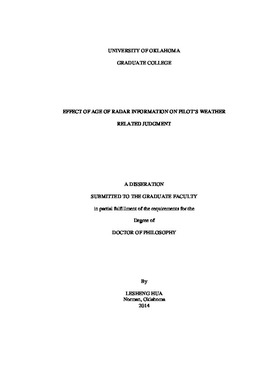| dc.description.abstract | Aeronautical data links that provided integrated information for long-term strategic planning and short-term decision aids in the cockpit will dominate future air-to-ground communications. However, data-linked weather information can be more than 14 minutes old by the time they reach the cockpit for use by pilots. The National Transportation Safety Board issued a warning that delayed radar information resulted in two fatal accidents. The reasons had been summarized as follows: pilots may not have been fully aware of the delay, and pilots treated radar information as real time and used it for tactical decision-making. Few studies have focused on how pilots interpreted delayed radar information. This study consisted of two experiments that contributed to three objectives: to develop an intuitive way to inform pilots of the delays and enhance their time awareness; to understand how pilots process delayed information and maintain spatial awareness; to objectively measures three stages of weather situation awareness.
The first experiment evaluated the effects of three types of time-stamp representation methodologies on participants’ accuracy for quick assessments of the delay of NEXRAD mosaic radar images. “Direct age”, “clock” and “UTC” timestamps were investigated with short, medium, and long levels of delay. Twenty-one participants compared two radar images, via their timestamps, to determine which one was more recent. The results indicated that “direct age” timestamp led to the highest accuracy and fastest response time, and was considered intuitive and easy to perceive by participants.
The second experiment contained three steps to evaluate the effect of time delay on distance estimation performance. These three steps represented the current understanding and projection stage of weather situation awareness. 30 student pilots completed the task, current and future proximity estimation to the storm cells based on the amount of time delay and movement speed. As expected, delayed radar information affected the pilots’ proximity judgments and deteriorated their weather situation awareness. In the first step, the participants overestimated the current location of the storm cell when the time delay was below 10-mins and storm-cell movement was less than 50 knots. In the second step, the participants underestimated the current distance between the aircraft and storm cells. In the third step, the participants overestimated the future distance when the time delay was long and the movement speed was fast. Participants used a conservative way to estimate the distance. Pilots could be trained to use delayed weather information to enhance spatial awareness, to make tactical decisions, to estimate current position of storm cell, and plan to avoid potential hazards. | en_US |
